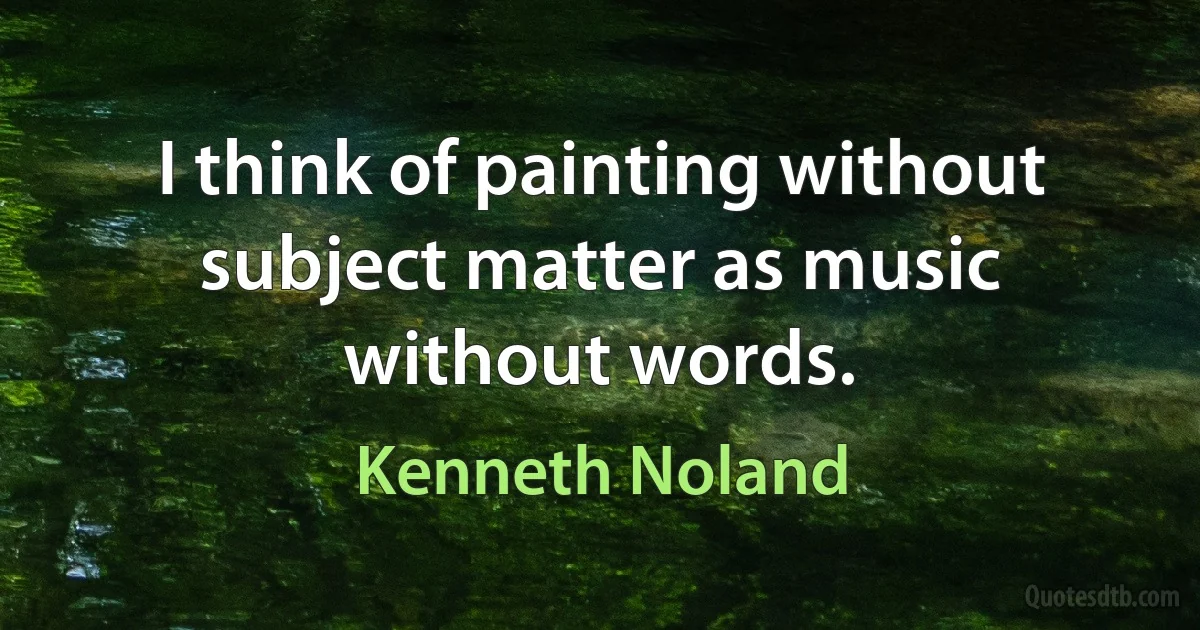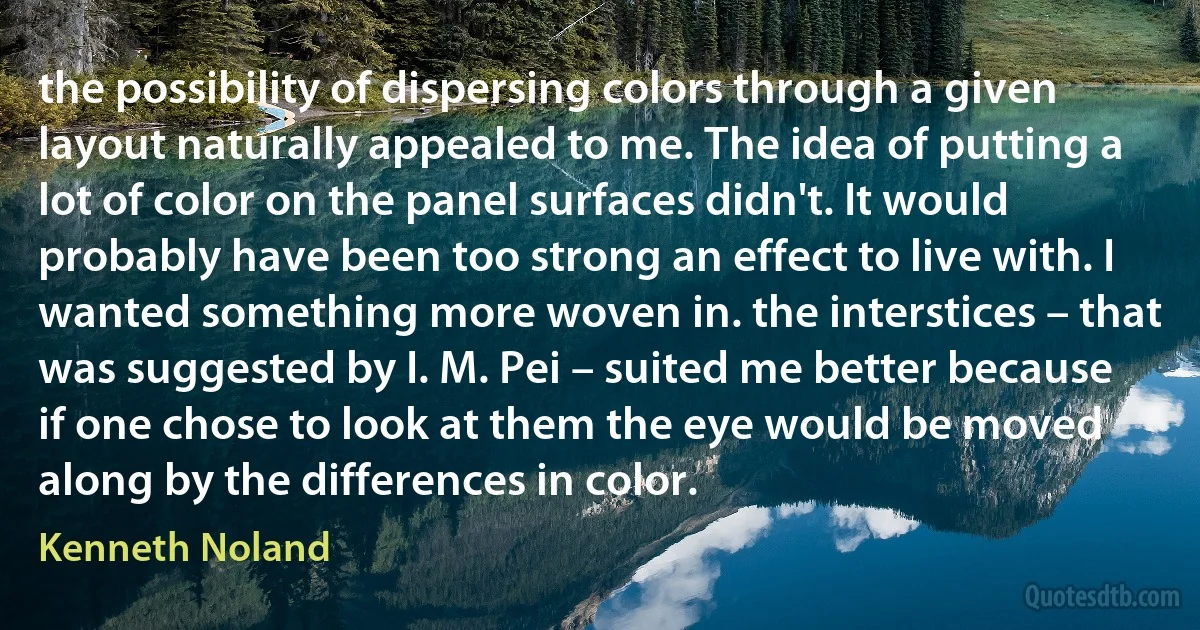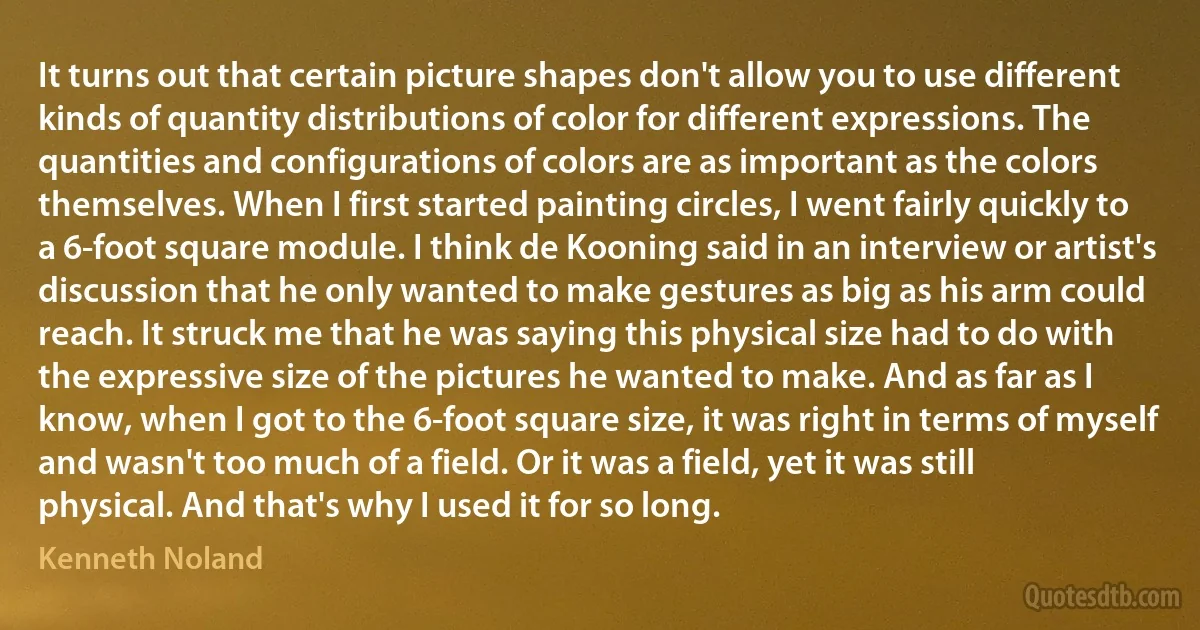Kenneth Noland quotes
Until Abstract Expressionism you had to have something to paint about, some kind of subject matter. Even though Kandinsky and w:Arthur Dove were improvising earlier, it didn't take. They had to have symbols, suggested natural images or geometry, which was something real structurally. That gave them something to paint about. What was new was the idea that something you looked at could be like something you heard.

Kenneth Noland
Tony Cairo [English abstract sculptor] and I tried to collaborate at several points and it hasn't been successful. As a matter of fact, recently Tony has made sculpture that I have painted. He has to make the sculpture before I can paint it. That means that the form is taking precedence – that the material takes precedence as a form, rather than color establishing the form. It's not going to well but I'm working on it. There's something about color that is so abstract that it is difficult for it to function in conjunction with solid form... Color has properties of weight, density, transparency, and so forth. And when it also has to be compatible with things that have an actual density, a given form, it's very difficult.

Kenneth Noland
It's been on my mind – what would something be like if it were unbalanced? It's been a vexing question for a long time. But it took the experience of working with radical kinds of symmetry, not just a rectangle, but a diamond shape, as well as extreme extensions of shapes, before I finally came to the idea of everything being unbalanced, nothing vertical, nothing horizontal, nothing parallel. I came to the fact that unbalancing has its own order. In a peculiar way, it can still end up feeling symmetrical. I don't know but what the very nature of our response to art is experienced symmetrically.

Kenneth Noland
Artists are mechanics who work with their hands, making things. Artists are involved with the means of creativity, the nature of skills, the revelation of making. Art comes from the work, I see a painting as an expressive entity. There's no picture that I know of where the subject carries as much expressive possibility as the actual execution of the picture.

Kenneth Noland
These things [cutting, cropping and shaping] always happen in strange ways. You can say after the fact what you're doing, but, believe me, you can't project it ahead. It has to be worked through before you can recognize what it was that you were looking for. It's a search; it's not like getting a brainstorm... It's work, yes; it comes out of the practice of painting, the practice of your art.

Kenneth Noland
I believe that there are varying points of contact. You have to be able to see the whole thing first. All great paintings are sculptures – there's so much of the factualness about it that a great painting forces you into a visual, physical movement of yourself. That's what determines the way you experience a painting kinetically. You move closer, you sight down it, you till your head, you step back, you feel as though you are in it. That being in it is just as important as looking from a distance.

Kenneth Noland
When you look at a great painting it's like a conversation. It has questions for you. It raises questions in you... Being an artist is about discovering things after you've done them. Like Cézanne – after twenty years of that mountain [Mont St. Victoire] he found out what he was doing. If it isn't a process of discovery, it shows. I'm in it for the long haul.

Kenneth Noland
But there was something else that the Abstract Expressionists taught us: they began to use something besides the conventional means of art; to want other kinds of paint, or kinds of canvas, or ways of making pictures that weren't the usual ways. Some of the next generation, the Pop Art artists [like Roy Lichtenstein and Andy Warhol, picked up this attitude and began to put actual things into art. We [=w:Morris Louis and Noland] were making abstract art, but we wanted to simplify the selection of materials, and to use them in a very economical way. To get to raw canvas, to use the canvas un-stretched – to use it in more basic or fundamental ways, to use it as fabric rather than as a stretched surface.

Kenneth Noland
Abstract Expressionism – especially Pollock, not the more academic painters like De Kooning – made the threshold between illusion and the stuff of painting lower, the distance between them closer. Pollock made all things about the picture, all the stuff, actual. Taking the canvas off the stretcher, putting it on the floor, made it more real. Mixing up different kinds of paint, getting it to stain in, was getting at a kind of materiality.

Kenneth Noland
In the 1950's there was a kind of agreement that a good artist would do something in his picture that acknowledge the edge, but it was a question of doing something when you got to the edge. Cropping was something new. It came from photography and from w:Clement Greenberg. It was resisted as being too easy.

Kenneth Noland
Kenneth Noland
Occupation: American ArtistBorn: April 10, 1924
Died: January 5, 2010
Quotes count: 38










